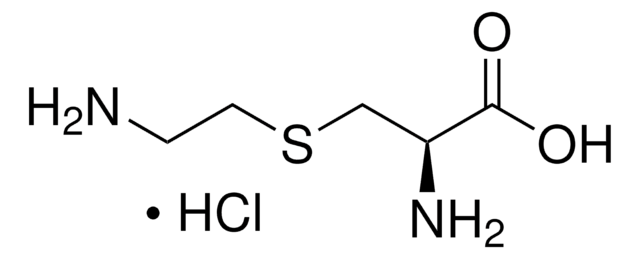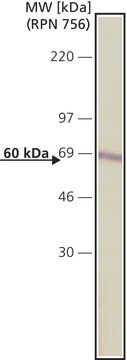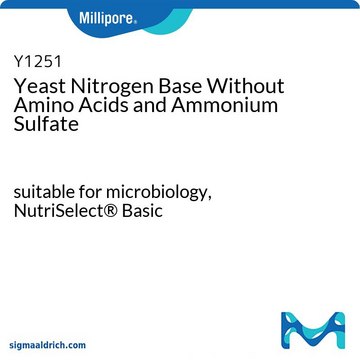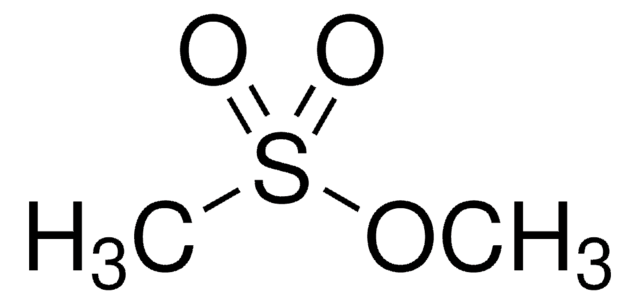C1625
L-Canavanine
≥98% (TLC), powder, from Canavalia ensiformis
Synonym(s):
L-α-Amino-γ-(guanidinooxy)-n-butyric acid
Sign Into View Organizational & Contract Pricing
All Photos(4)
About This Item
Empirical Formula (Hill Notation):
C5H12N4O3
CAS Number:
Molecular Weight:
176.17
MDL number:
UNSPSC Code:
12352209
PubChem Substance ID:
NACRES:
NA.26
Recommended Products
Product Name
L-Canavanine, ≥98% (TLC), powder, from Canavalia ensiformis
biological source
Canavalia ensiformis
Quality Level
Assay
≥98% (TLC)
form
powder
color
white to yellow
solubility
H2O: <100 mg/mL
application(s)
detection
storage temp.
2-8°C
SMILES string
N[C@@H](CCONC(N)=N)C(O)=O
InChI
1S/C5H12N4O3/c6-3(4(10)11)1-2-12-9-5(7)8/h3H,1-2,6H2,(H,10,11)(H4,7,8,9)/t3-/m0/s1
InChI key
FSBIGDSBMBYOPN-VKHMYHEASA-N
Biochem/physiol Actions
Canavanine is a naturally occurring L-amino acid that interferes with L-arginine-utilizing enzymes due to its structural similarity. It is a selective inhibitor of inducible nitric oxide synthase (iNOS). Overproduction of NO by iNOS plays a crucial role in the pathophysiology of septic shock and chronic inflammation.
A naturally occurring L-amino acid that interferes with L-arginine-utilizing enzymes due to its structural similarity. It is a selective inhibitor of inducible nitric oxide synthase (iNOS). Overproduction of NO by iNOS plays a crucial role in the pathophysiology of septic shock and chronic inflammation.
Signal Word
Warning
Hazard Statements
Precautionary Statements
Hazard Classifications
Acute Tox. 4 Dermal - Acute Tox. 4 Inhalation - Acute Tox. 4 Oral
Storage Class Code
11 - Combustible Solids
WGK
WGK 3
Personal Protective Equipment
dust mask type N95 (US), Eyeshields, Gloves
Choose from one of the most recent versions:
Already Own This Product?
Find documentation for the products that you have recently purchased in the Document Library.
Customers Also Viewed
E Arthur Bell
Amyotrophic lateral sclerosis : official publication of the World Federation of Neurology Research Group on Motor Neuron Diseases, 10 Suppl 2, 21-25 (2009-12-16)
Because of the similarity of ALS/PDC symptoms to those of the paralytic disease lathyrism, cycad seeds from Guam were analyzed for the presence of the non-protein amino acid b-ODAP, which is known to cause lathyrism. Although b-ODAP was not detected
Youngseok Lee et al.
The Journal of neuroscience : the official journal of the Society for Neuroscience, 32(4), 1429-1435 (2012-01-27)
Insect survival depends on contact chemosensation to sense and avoid consuming plant-derived insecticides, such as L-canavanine. Members of a family of ∼60 gustatory receptors (GRs) comprise the main peripheral receptors responsible for taste sensation in Drosophila. However, the roles of
Ya-Lan Chang et al.
Antioxidants & redox signaling, 22(7), 587-602 (2014-10-21)
Mitochondrial succinate dehydrogenase (SDH) is an essential complex of the electron transport chain and tricarboxylic acid cycle. Mutations in the human SDH subunit D frequently lead to paraganglioma (PGL), but the mechanistic consequences of the majority of SDHD polymorphisms have
Nami Haruta et al.
Nucleic acids research, 40(17), 8406-8415 (2012-06-30)
UV radiation induces two major types of DNA lesions, cyclobutane pyrimidine dimers (CPDs) and 6-4 pyrimidine-pyrimidine photoproducts, which are both primarily repaired by nucleotide excision repair (NER). Here, we investigated how chronic low-dose UV (CLUV)-induced mutagenesis occurs in rad14Δ NER-deficient
Nayun Kim et al.
Science (New York, N.Y.), 332(6037), 1561-1564 (2011-06-28)
The ribonuclease (RNase) H class of enzymes degrades the RNA component of RNA:DNA hybrids and is important in nucleic acid metabolism. RNase H2 is specialized to remove single ribonucleotides [ribonucleoside monophosphates (rNMPs)] from duplex DNA, and its absence in budding
Our team of scientists has experience in all areas of research including Life Science, Material Science, Chemical Synthesis, Chromatography, Analytical and many others.
Contact Technical Service
















